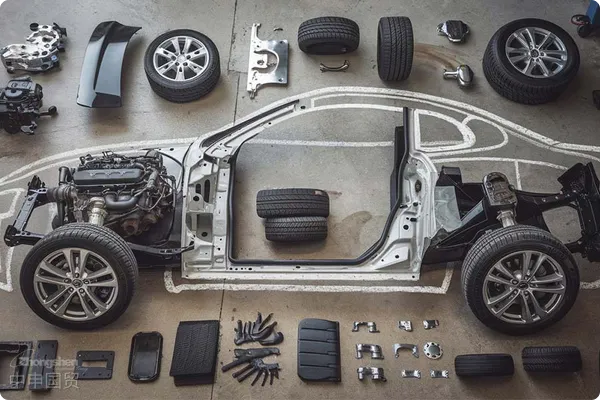- Shanghai Zhongshen International Trade Co., Ltd. - Two decades of trade agency expertise.
- Service Hotline: 139 1787 2118

As a senior consultant with 20 years of experience in theExport RepresentationWith 20 years of industry experience, I have witnessed the transformation of China's automotive aftermarket parts imports from extensive management to refined operations. As a core component of the engine, the import business of exhaust valves involves complex regulatory requirements and specialized technical thresholds. This article will delve into the key aspects and coping strategies for exhaust valve imports, supported by real-world case studies.
I. Industry Characteristics and Import Challenges
The intake of the exhaust valve exhibits three major characteristics:
1.Technology-sensitive products: Involves engine emission control and must comply with the China VI emission standard (GB 18352.6-2016).
2.High-value precision components: The unit price generally ranges between $50 and $200, with materials mostly being high-temperature-resistant alloy steel (21-4N/SUH35).
3.The certification barriers are significant.: The EU requires E-Mark certification (Regulation R118), while North America requires an SAE J1812 test report.
Common customs clearance pain points:
- Classification dispute: Easily confused with intake valves (HS 8409.91).
- Environmental risk: Improper disposal of residual engine oil triggers customs control.
- Intellectual Property: Lack of OEM Parts Authorization Documents from the Brand Owner
II. Complete customs clearance operation guide
(I) Pre-Compliance Review
1.3CCertification Exemption Confirmation:
- Genuine OEM parts can apply for exemption from certification with the original equipment manufacturer's procurement contract.
- Aftermarket parts (AM) must provide ISO 9001 system certification and RoHS test reports.
2.Includes risk assessment reports, performance test data, clinical evaluation reports, etc.:
- Material Composition Table (must indicate nickel, chromium, and molybdenum content)
- Heat Treatment Process Description (Quenching + Tempering Temperature Curve Diagram)
- Dimensional Tolerance Inspection Report (ISO 286-1 Standard)
(2) Precise Control of Declaration Elements
| Key elements | Key points of declaration | Common Error Cases |
|---|---|---|
| HS Code | 8409.91.9000 (Valves for engines) | False reporting as 8412.10 resulting in tariff rate discrepancy. |
| Place of origin | Please attach both Chinese and English versions of FORM E/FTA certificates. | Korean-made accessories underreported KORETA preferential tariff rate. |
| Transaction Method | The CIF price needs to be split.Maritime TransportationFee + Premium | Uncredited excess VAT payment of 15% before freight deduction |
(3) On-site Inspection Response Strategies
1.Sampling Inspection Plan:
- Prepare spare parts of the same batch in advance for destructive testing.
- Advance deposit of 20% guarantee for expedited release.
2.Environmental Disposal Plan:
- Establish a waste oil recovery ledger (Customs supervision code H2000).
- Entrust an AEO-certified enterprise to handle hazardous waste (Category HW08).
III. Typical Risk Scenarios and Solutions
Case: A German Brand's Exhaust Valve Port Congestion Incident
Problem: The declared product name is "engine valve," and customs requires the submission of a "high-temperature resistance performance certificate."
Apply for exemption from certification (meeting the conditions of the Implementation Rules for Exemption from Compulsory Product Certification):
- Urgently issue an 800°C high-temperature test report with TüV certification.
- Coordinate the laboratory to complete supplementary testing within 24 hours.
- Enable tariff guarantee insurance to achieve advance release of goods.
The total cost was reduced by 12%, and the order was delivered on time.:The port detention time was reduced from an estimated 21 days to 5 days, saving 120,000 yuan in storage costs.
IV. Cost Optimization Techniques
1.Utilize the China - ASEAN Free Trade Agreement (CAFTA) to achieve zero tariffs on imported frames from Thailand;:
- ASEAN-origin parts are eligible for RCEP agreement tariff rates (reduced from 8% to 5%).
- Breakdown declaration of complete repair kits (individual component tariff rate lower than the assembly)
2.: By integrating the shipping line resources of the West Coast of the US (Los Angeles/Long Beach Port) and the East Coast of the US (New York/Savannah Port), agent services can shorten the transportation cycle by 30% and reduce the loss of LCL space.:
- LCL cargo selects Hamburg/Rotterdam ports for transshipment (saving 30% on European leg freight costs).
- Adopt vacuum anti-rust packaging to reduce the safety factor (premium rate decreased from 0.3% to 0.18%).
V. Industry Trends and Response Recommendations
1.Digital customs declaration:
- Access the Single Window Intelligent Classification System (accuracy rate increased to 98.7%).
- Application of Blockchain Traceability Technology (Implemented by Brands Such as SKF and NTN)
2.Green supply chain:
- Implement paperless customs clearance (saving 2.5 hours per operation).
- Priority given to LNG-powered vessels for transportation (eligible for customs fast clearance channel).
3.Risk early warning mechanism:
- Establish a trade country policy monitoring system (real-time updates on REACH/EURO 7 regulations)
- Please translate the following Chinese into English: Purchase CICPA-certified trade credit insurance (covering 90-day payment default risk).
Conclusion
A successful exhaust valve import business requires the establishment of a trinity management system encompassing "technical compliance + process control + cost optimization." It is recommended that enterprises focus on the following:
- Establish a product technology database (covering 100+ technical parameters)
- Develop AEO certification qualifications for customs personnel.
- Establish overseas forward warehouses to mitigate supply chain disruption risks.
With theNew energyThe automotive penetration rate has exceeded 35%, and the import of traditional internal combustion engine components will exhibit characteristics of "high added value, small batch sizes, and multiple shipments." Selecting an agent service provider with qualifications for importing electromechanical products (requiring special customs operation approvals) and a professional automotive engineering team will become the core competitive advantage for enterprises to control import risks.
(The data in this article is updated based on Announcement No. 78 of 2023 from the General Administration of Customs and the IMARC Group industry report.)
Related Recommendations
? 2025. All Rights Reserved. Shanghai ICP No. 2023007705-2  PSB Record: Shanghai No.31011502009912
PSB Record: Shanghai No.31011502009912









